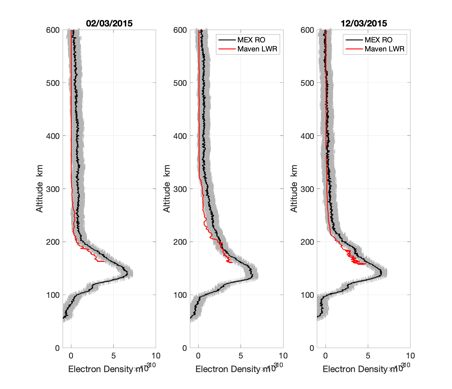- 1Royal Observatory of Belgium, Brussels, Belgium (ozgur.karatekin@oma.be)
- 2Earth and Life Institute, UCLouvain, Belgium
- 3Université de Liege, Belgium
- 4University of Leicester, United Kingdom
- 5European Space Agency, Noordwijk, The Netherlands
Electron density structure and its temporal/spatial variations is one of the critical quantities in understanding an upper atmosphere. Mars has currently several orbiters studying its upper atmosphere and in particular electron density profiles. The Mars Express (MEX), in the orbit since 2003 has been measuring Mars upper atmosphere through remote measurements by the MARSIS (Sub-Surface Sounding Radar Altimeter) sounder and radio occultations by MaRS (Radio Science Experiment - sounding of the internal structure, atmosphere and environment). The Mars Atmosphere and Volatile EvolutioN, MAVEN mission whose science objectives include exploration of the interactions of the Sun and the solar wind with the Mars magnetosphere and upper atmosphere has complete plasma package. Maven has been performing in-situ composition measurements since November 2014, in particular, the Langmuir Probe and Waves (LPW) instrument onboard MAVEN provide electron density using current-voltage sweeps.
Here we present the comparison of multi-instrument spacecraft measurements of Mars upper atmosphere for selected dates, using remote sensing (MEX) and in-situ measurements (MAVEN). The mutual observations are selected from publicly available data on ESA Planetary Science Archive as well as MAVEN Science Data Center. The L2 level Radio Occultation data are analyzed to obtain the Mars upper Atmosphere Electron density profiles. The MARSIS and LPW provide top side electron profiles whereas Radio occultations provide the full electron density profile. We focuse on the photochemical equilibrium region of the Martian ionosphere–thermosphere below 200 km. The analysis also includesz the Deep Dip campaigns of MAVEN making in-situ measurements of the region near the ionospheric peak.
The comparison of independent measurements using different techniques will be presented and the differences and similarities between the observations will be discussed to help to validate our understanding of the physical and chemical processes occurring in the atmosphere.

Figure 1: Comparison of MEX Radio Occultations (RO) with the MAVEN Langmuir Probe and Waves (LPW) for 3 selected mutual observation in March 2015
How to cite: Karatekin, Ö., Krishnan, A., Verkercke, S., Henry, G., Sánchez-Cano, B., and Witasse, O.: Multi-instrument/Spacecraft observations of Mars upper Atmosphere Electron density, Europlanet Science Congress 2022, Granada, Spain, 18–23 Sep 2022, EPSC2022-688, https://doi.org/10.5194/epsc2022-688, 2022.

